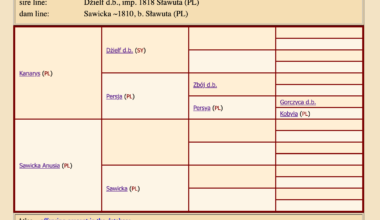“Gnaidy” simply means the color bay in Polish and Russian. Sources indicate this horse was purchased by Burski during his travels to Aleppo via Istanbul for Prince Hieronim Sanguszko. Nothing more is known.
The earliest known source that mentions Gnaidy is the 1860 history of the stud published in Russian. “Bursky brought five stallions: “Krolik” (Rabbit), “Kariy” (Brown), “Bely” (White), “Gnedoy” (Bay), and the coat of the fifth stallion is unknown. Of these horses, Brown and White were bought by Count Vaclav Rzhevusky, and the Bay went to Prince Eustachy Hieronimovich Sanguszko, who sold him several years later to Getman Branitsky for 1000 ducats. The groom of the Hetman, Mr. Smolensky, who served for three generations of the Branitsky family, recalled that this stallion had narrow flanks and passed on this undesirable trait to his offspring.”
S. Wotowski, the editor of the influential Polish equine publication “Jeździeć i Myśliwy,” writes about Gnaidy in his article titled Sanguszko Horses in 1891: “We encounter the first records of a horse-sourcing expedition sent east in the year 1801. In this year, Prince Hieronim sent his courtier, Mr. Burski, to buy some stallions. Burski returned sometime in 1804, having spent some of the money on himself, and brought back less horses than he was meant to. The imported stallions are recorded by their coat color in the stud books: one was a “królik” – rabbit-like, that is, white and pink; “skarogniady” one (dark bay), “gniady” one (bay), a white one, and one whose coat color is not known.


